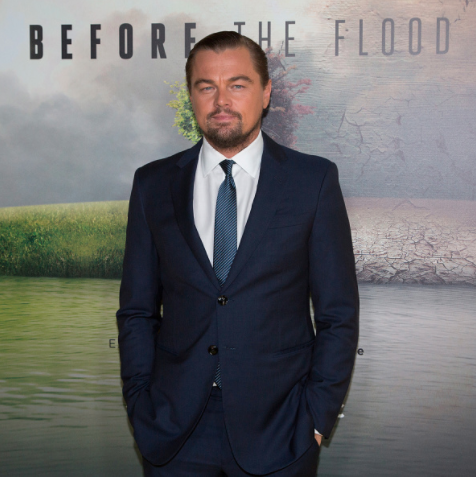There’s a well documented rule when it comes to suits with three buttons, it’s as easy as: “sometimes, always, never” — Sometimes button up the top button, always button up the middle one, and never button-up the bottom one.
In a two-buttoned suit, one should always button up the top and never the second button.
But don’t take our word for it. Ask style mogul, Leo DiCaprio:
ALSO SEE: Kate Middleton channels Jackie O. during Easter Sunday service
But where did the tradition come from?
Legend goes that in the early 19th century, Britain’s King Edward VII grew too fat for his suit and had to stop using the second button as a result. Not wanting to embarrass him, everyone followed.
The “Edwardian theory,” as GQ U.K.’s fashion director Robert Johnson calls it, isn’t always taken seriously. It sounds too far fetched to be true. But historians of British fashion consider it fact — at least partly fact, the story has become a little muddled over the years.
According to Sir Hardy Amies, an English fashion designer who was the official dressmaker for Queen Elizabeth II for nearly four decades — suit jackets are unbuttoned at the bottom because they replaced horse-riding jackets.
In a 1992 lecture he gave to The Royal Society for the Encouragement of Arts, Manufactures and Commerce, Amies traced the story of “The Englishman’s Suit” from 1670 to his present day. The single-breasted suit of today was first introduced in 1906, at the time of Kind Edward’s reign, and was referred to as a “lounge suit.”
The lounge suit began to replace traditional riding coats. So they had to be unbuttoned so the jacket draped properly while someone was sitting on a horse.
Edward VII decided that the top button should also be undone because it “looked common,” according to Amies, leaving only the middle button done up.
It was however, the King’s growing belly that changed the style rules around wearing waistcoats.
“Edward VII always left his bottom waistcoat button open because he was fat,” said Amies. “He found it more comfortable and everybody copied it. Waistcoats are now cut for the last button not to be done up.”
ALSO SEE: A body language expert breaks down Prince Harry and Meghan Markle’s photos
The trend, the Oxford Dictionary notes, “was followed in this in Britain and the empire but not on the continent or in the U.S.A.” But nowadays, unbuttoning the bottom of the waistcoat is also the norm.
So there you have it. Let us carry on dressing (and eating) like kings!
Let us know what you think by tweeting @YahooStyleCA!
I'm a style enthusiast with a deep understanding of sartorial traditions and fashion history. My expertise extends to the intricacies of suit etiquette and the evolution of men's fashion over the years.
Now, let's delve into the concepts mentioned in the article about suit buttoning rules:
-
"Sometimes, Always, Never" Rule for Three-Button Suits:
- This traditional guideline suggests that for a three-button suit, one should sometimes button the top button, always button the middle one, and never button the bottom one. It's a classic rule that adds a touch of sophistication to the wearer's appearance.
-
Two-Button Suit Etiquette:
- In a two-buttoned suit, the rule is simpler: always button up the top button and never the second button. This provides a clean and polished look, emphasizing the simplicity of the two-button design.
-
Origin of the Tradition - King Edward VII:
- The article mentions the legend surrounding King Edward VII in the early 19th century. As the story goes, the King grew too fat for his suit, leading him to stop using the second button. To avoid embarrassment, those around him followed suit, and this became known as the "Edwardian theory."
-
The "Edwardian Theory" and Historical Accuracy:
- The article acknowledges that the "Edwardian theory" might sound far-fetched but is considered partly factual by historians of British fashion. It explains that the story has become somewhat muddled over the years.
-
Sir Hardy Amies' Insights:
- Sir Hardy Amies, an English fashion designer, provides insights into why suit jackets are unbuttoned at the bottom. He traces the evolution of the "lounge suit" from 1670 to his present day, noting that it replaced traditional riding coats. Edward VII's preference for unbuttoning the top button influenced the style, leaving only the middle button done up.
-
Waistcoat Buttoning Rules:
- The article explains that Edward VII's growing belly changed the rules for wearing waistcoats. The King left his bottom waistcoat button open for comfort, and this trend became widely adopted. Nowadays, waistcoats are cut for the last button not to be done up.
-
Oxford Dictionary's Note:
- The article mentions that the trend was followed in Britain and the empire but not on the continent or in the U.S.A. It reflects how fashion traditions can vary across regions.
In conclusion, the rules and traditions surrounding suit buttoning have a rich history rooted in both practical considerations and royal fashion preferences, contributing to the timeless elegance associated with well-tailored suits. If you have any questions or would like further insights, feel free to ask!


